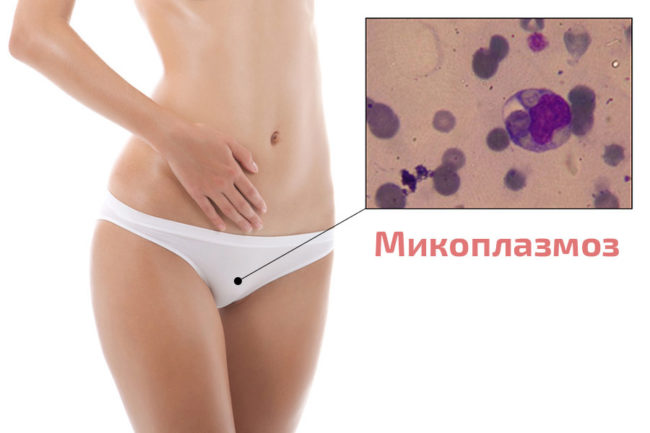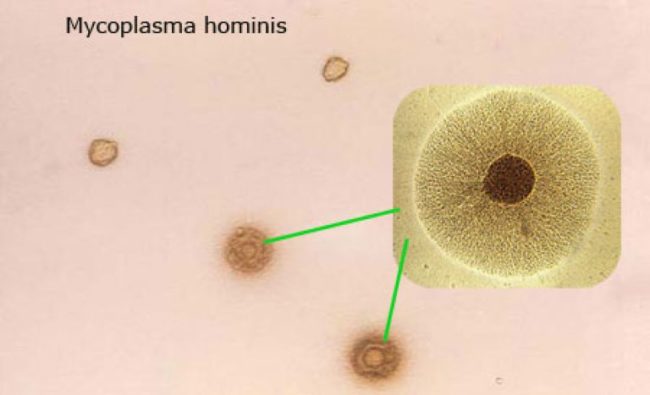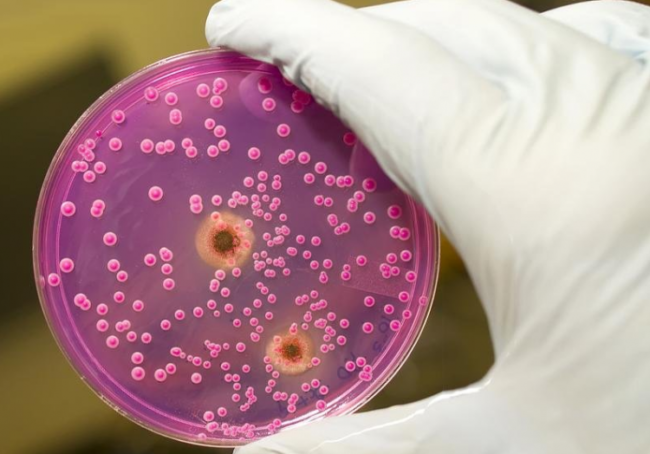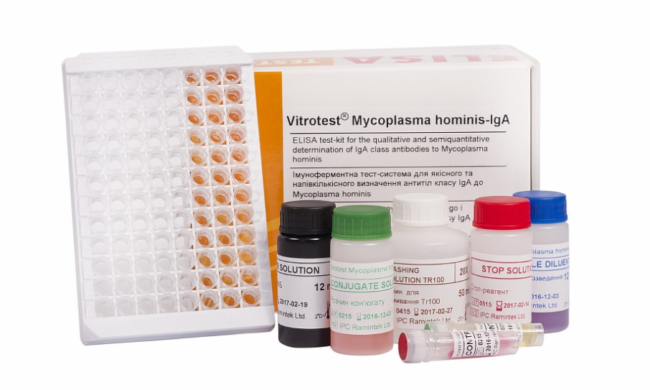Mycoplasma -This is the smallest microorganism, considered something average (intermediate) between the bacteria and the virus. It does not have a cell wall and exists on the cells of the "master" body, while actively parasitizing. Most often, you can find such a parasite on the cells of the epithelium of the respiratory tract, intestines, genitourinary system. Below we will talk about what mycoplasma for women is dangerous, how to diagnose it and how to treat it.
Content
Types of mycoplasma in women

Pathogenic microorganism has a cellular structure than similar to bacteria, but does not have a cell membrane as viruses and is able to live outside the cells. Its membrane represents a film (plasmalem), consisting of lipids and protein molecules. When attaching to the epithelium of the genitourinary system or respiratory organs, the parasite provokes the appearance of local inflammation. Penetrating into the thickness, mycoplasma interacts with cells, changing their structure, which leads to the development of an autoimmune process. Parasites propagate at a quick pace, by the method of budding. In the external environment, there are many varieties of mycoplasm, but only some of them are dangerous for the human body.
- Pneumonia mycoplasma (Mycoplasma pneumoniae) - causes a person in a person the development of bronchitis, pneumonia, atypical form of pneumonia and other respiratory diseases of the respiratory system.
- Mycoplasma Hominis (Mycoplasma) - The main "culprit" of vaginosis and urogenital mycoplasmosis. Most often, mycoplasma Hominis is found in women in urinary organs.
- Micoplasma Genitalium (Mycoplasma Genitalium) - It is the cause of the appearance of diseases of the genitourinary system. Micopoplasma genitalium in both women and men can cause ureaplasmosis.
- Micoplasma Fermentans and Mycoplasma Penetrans and Mycoplasma Penetrans - They are present in the diagnosis of HIV positive people, this gives reason to assume that these microorganisms contribute to the development of AIDS.
- Ureaplasma ureaplasma - One of the types of microorganism, which is able to split urinary acid. Ureaplasma and mycoplasma in women contribute to the development of ureaplasmosis, which can provoke the appearance of pelvic diseases, inflammation of the ovaries, vaginitis, cervicitis, damage to the uterine pipes, which stretches infertility.
The causes of mycoplasma in women

In a slight amount, the presence of mycoplasma is the norm. In women who have no health problems, these microorganisms do not cause pathogenic processes. But as soon as a deficiency of the immune system occurs, the body's work fails and any adverse conditions can activate the reproduction of mycoplasma. In women, the causes of “starting” pathology can be as follows:
- hypothermia;
- general exhaustion of the body caused by physical or moral reboots;
- constant being in a state of stress;
- radiation therapy;
- transferred gynecological diseases;
- the appearance of a sexually transmitted infection;
- reception of certain hormonal drugs or antibiotics.
These microorganisms cannot continue their vital activity without a “owner” cage. Therefore, in the external environment of their life, the ability is extremely small. Therefore, it is impossible to “pick up” the parasite in everyday life (the exception is only mycoplasma pneumoniae). But the occurrence of mycoplasma in women can serve:
- sexual intercourse with a parasite carrier;
- vertical infection, when microorganisms are transmitted from mother to newborn in the process of labor.
Mycoplasma during pregnancy

Mycoplasma in pregnant women is not uncommon. Since even before conception, many women have such a problem, but in a hidden form. The danger of exacerbation of parasitization of pathogenic microorganisms in this position can lead to the appearance:
- bleeding;
- chronic toxicosis in the late stages;
- placenta detachment;
- early discharge of water.
In critical situations, early birth can occur or obstetric abortion will be needed.
In the presence of mycoplasma in women during pregnancy, the pathogenic process can develop on the cells of the embryo, leading to the focal inflammatory process. This is often the reason that the child is born with intrauterine development of development, pneumonia or meningitis.
As for the treatment of mycoplasma during pregnancy, it is carried out only if the colony of these microorganisms is a danger to a pregnant woman or fetus.
Symptoms of mycoplasma in women

After infection, the incubation period can last from a couple of days to two months. In most cases, mycoplasmas in women do not occur even after this period. Exacerbations occur if there are “favorable” conditions for the activation of microorganisms (the appearance of infection, immunity deficiency, chlamydia, fungus, etc.).
The following non -specific signs of mycoplasma in women who appear during exacerbation, regardless of the pathogen (exclusion of Mycoplasma pneumonia) can indicate the presence of parasites in the body::
- burning and tooth during urination;
- discomfort and pain during sex;
- pain syndrome in the lower abdomen;
- colorless discharge, they can be scarce or abundant;
- bleeding not related to menstruation;
- constantly present general weakness;
- low's pain.
It is impossible to diagnose mycoplasmas of genitalia in women by symptoms. The clinical picture can “adapt” to a number of diseases based on the localization of the inflammatory process caused by microorganisms.
As for the pneumonia mycoplasma (Mycoplasma pneumoniae), more detailed information about the symptoms, the development of the clinical picture and treatment can be found on the video.
Diagnosis of mycoplasma in women
It is impossible to identify the presence of microorganisms in the usual way (a smear on a microflora, examination, a general blood test). It is necessary to conduct special studies for the identification of microorganisms. For the fences of the material, a smear for mycoplasma in women with:
- cervix of the uterus;
- vagina;
- district of the urethra.
In addition to the smear, experts insist on the study of urine, the fence of which is made in the morning.

Specific analyzes for mycoplasma in women are the following:
- polymerase chain reaction (PCR) - The method allows you to calculate the presence of plasma DNA of mycoplasma in the studied material. The accuracy of such a diagnosis is 95%, and the answer is already known after 30 minutes;
- bacteriological sowing - In the biological material, the patient is artificially grown by microflora to detect pathogenic organisms. The method is 100%, but long (5-7 days);
- immunofluorescent diagnostic method - aims at the detection of immunosorbont antibodies in the blood through the introduction of a special dye. It is considered the “weak” method of diagnosing the presence of mycoplasma.
It should be noted that there are cases of a false positive or false negative result. Therefore, it is advisable to repeat the diagnosis after a certain period of time (after treatment).
How to treat mycoplasma in women?
With mycoplasma in women, treatment with medicines begin to be carried out only in cases where the diagnosis has confirmation by appropriate analyzes. The complexity of therapy is associated with the absence of a shell in microorganisms, which makes them immune to a certain group of antibiotics (penicillins, cephalosporins). For treatment, it is not used drugs that destroy the walls of the cells of microorganism, but the antibiotics of the new generation with another effect on parasites.
Mycoplasma in women - treatment regimen

In order to treat this pathology, the specialist must develop a special comprehensive treatment regimen. It should include:
- relevant antibiotics;
- local impact on the colony of mycoplasma (candles, douching);
- immunomodulating drugs;
- special diet;
- if necessary, physiotherapy.
The purpose is based on the pathogen, since for each type of mycoplasma its current antibiotic is needed.
Treatment of mycoplasma in women with medical drugs

The therapy of the disease is long. Even with the disappearance of all symptoms, you should not stop taking drugs. Since microorganisms will rapidly multiply in a new one and relapse cannot be avoided.
Mycoplasma in women is treated with drugs of the following row:
- for 10 days, antibiotics of the tetracycline series (tetracycline, ciprofloxacin, doxycycline) to eliminate the colonies of mycoplasma;
- for 7 days, prescribe local drugs (candles and douching), which have an anti -inflammatory effect and eliminate itching;
- they also treat the vagina using tampons with chimotripsin or thripsin;
- since no antibiotics are recommended without bias, they are taken throughout the treatment.
Most often prescribed a prescription for such types of drugs:

Treatment of a sexual partner for mycoplasma in women

If a woman has a diagnosis, two sexual partners should undergo treatment. Otherwise, with each sexual intercourse, infection will be carried out again, and treatment will become ineffective. According to the medical “standard”, the therapy rate is up to 15 days. During the treatment with intimate relationships, it is worth postponing and completely abandoning sex.
After therapy is completed, after 14-16 days it is necessary to re -be checked for the presence of mycoplasma in the body.
How common is mycoplasma in women
If you think that the presence of mycoplasma in the body is “this is not about me”, then you will have to upset you. Almost 80% of women in the smear of vagina find Ureaplasma, and in 28–53% - Mycoplasma hominis. Since microorganisms are in a latent or subclinical state, there is no corresponding symptoms. But when any stress factors appear, active reproduction begins, which becomes the result of the inflammatory process.
To declare that parasites in most cases are transmitted in debt by debatable, since recent studies have shown that up to 18% of school -age girls who have never had intimacy are the bearers of Mycoplasma hominis. These figures may indicate intra -family infection in everyday life or of huge unlimited numbers of the vertical infection route, which is recorded only in situations of intrauterine infection of the fetus that are diagnosed. Statistics show that in 57 cases out of 100 in mothers with mycoplasmas even in a sleeping state, girls with Mycoplasma hominis are born on the labia.
It should also be noted that when diagnosing urogenital infection in 80% of cases, mycoplasma is present, and in women with a diagnosis of infertility a “culprit” in 51% of the case, it is precisely this microorganism.
It is possible to avoid or preserve the disease in a latent state. To do this, you need to have one sexual partner. Use a condom for sexual intercourse. Undergo an examination by a gynecologist every six months. To treat already present diseases of the genitourinary system. Attention to your health will minimize the risk of pathology.









Comments
a couple of years ago, there was no side of metrogils from the same problem, there were no side effects ...
I’m not a fan of peeling at all, it saves from acne of metrogil, it also smoothes it ...
Great article! ...
I take the second course of the Capsules Climafite 911. The tides went very quickly. It became calmer, irritability went away and I sleep well ...
i also noticed - it is worth nervous, everything immediately affects the face. Therefore, I try to avoid conflicts and unpleasant people. Of the creams, I like Miaflow from wrinkles - smoothes not only small wrinkles ...